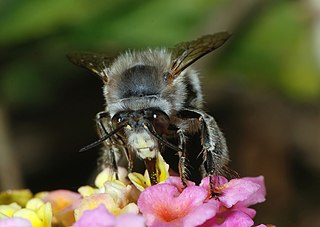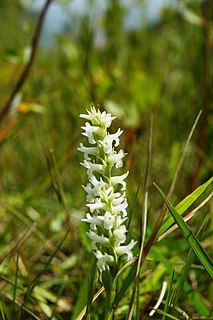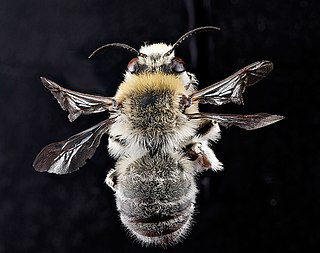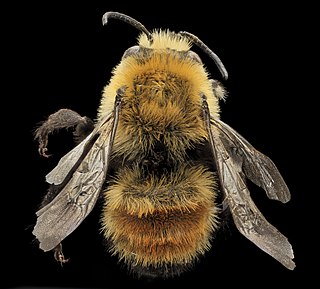
The bee genus Anthophora is one of the largest in the family Apidae, with over 450 species worldwide in 14 different subgenera. They are most abundant and diverse in the Holarctic and African biogeographic regions. All species are solitary, though many nest in large aggregations. Nearly all species make nests in the soil, either in banks or in flat ground; the larvae develop in cells with waterproof linings and do not spin cocoons. Males commonly have pale white or yellow facial markings, and/or peculiarly modified leg armature and hairs. Anthophora individuals can be distinguished from the very similar genus Amegilla by the possession of an arolium between the tarsal claws.

Gentiana andrewsii, the bottle gentian, closed gentian, or closed bottle gentian, is an herbaceous species of flowering plant in the gentian family Gentianaceae. Gentiana andrewsii is native to northeastern North America, from the Dakotas to the East Coast and through eastern Canada.

The hairy-footed flower bee is a species of bee belonging to the family Apidae.

Spiranthes diluvialis is a rare species of orchid known as Ute lady's tresses. The species name diluvialis means "of the flood". It is native to the western United States, where there are scattered, mostly small occurrences in the states of Colorado, Idaho, Montana, Nebraska, Nevada, Utah, Washington, and Wyoming. An occurrence was recently discovered in southern British Columbia. The plant faces a number of threats to its existence. It is a federally listed threatened species of the United States.

Coelioxys, common name leaf-cutting cuckoo bees or sharp-tailed bees , is a genus of solitary kleptoparasitic or brood parasitic bees, belonging to the family Megachilidae.
Anthophora fedorica is a species of anthophorine bee in the family Apidae. It is found in North America.

Anthophora ursina is a species of anthophorine bee in the family Apidae. It is found in North America.
Anthophora pacifica is a species of anthophorine bee in the family Apidae. It is found in North America.
Anthophora villosula is a species of anthophorine bee in the family Apidae.

Anthophora montana, the Rocky Mountain anthophora, is a species of anthophorine bee in the family Apidae. It is found in Central America and North America.

Anthophora californica, the California anthophora, is a species of anthophorine bee in the family Apidae. It is found in Central America and North America.
Xylomya terminalis is a species of fly in the family Xylomyidae.

Anthophora occidentalis, known generally as the western anthophora or digger bee, is a species of anthophorine bee in the family Apidae. It is found in North America.

Anthophora bomboides, the bumble-bee-mimic anthophora, is a species of anthophorine bee in the family Apidae. It is found in North America.
Anthophora centriformis is a species of anthophorine bee in the family Apidae. It is found in Central America and North America.
Anthophora crotchii, or Crotch's anthophora, is a species of anthophorine bee in the family Apidae. It is found in North America.

Anthophora urbana is a species of anthophorine bee in the family Apidae. It is found in Central America and North America.
Anthophora walshii, or Walsh's anthophora, is a species of anthophorine bee in the family Apidae. It is found in North America.

Anthophora abrupta is a species of anthophorine bee in the family Apidae. It is found in North America.

Anthophora retusa, the potter flower bee, is a species of solitary digger bee.













